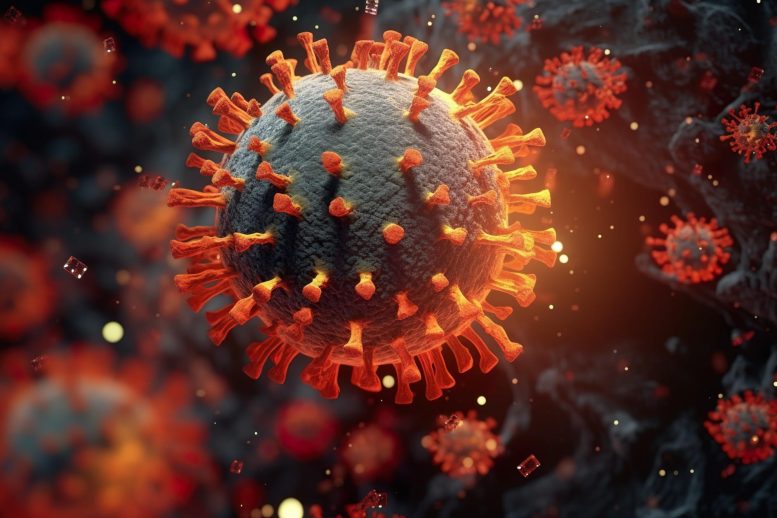Long COVID, affecting 5-10% of COVID-19 patients, might be caused by the enduring presence of the virus in the body.
Research suggests that viral fragments, possibly live, linger and lead to symptoms. Addressing this involves antiviral treatments, enhanced public awareness, and preventive measures against reinfection.
Understanding Long COVID and Its Prevalence
About 5–10% of people infected with COVID-19 develop long COVID, experiencing symptoms that last three months or longer.
Scientists have suggested several biological mechanisms to explain long COVID. However, in a recent perspective article in the Medical Journal of Australia, we propose that long COVID may largely be caused by the virus itself persisting in the body.
Since the early days of the pandemic, researchers have recognized that SARS-CoV-2 — or its remnants — can remain in different tissues and organs long after the initial infection. This phenomenon is referred to as “viral persistence.”

Credit: SciTechDaily.com
Evidence of Persistent Virus and Its Implications
While the long-term presence of residual viral fragments in some people’s bodies is now well established, what remains less certain is whether live virus itself, not just old bits of virus, is lingering – and if so, whether this is what causes long COVID. This distinction is crucial because live virus can be targeted by specific antiviral approaches in ways that “dead” viral fragments cannot.
Viral persistence has two significant implications:
- when it occurs in some highly immunocompromised people, it is thought to be the source of new and substantially different-looking variants, such as JN.1
- it has the potential to continue to cause symptoms in many people in the wider population long beyond the acute illness. In other words, long COVID could be caused by a long infection.
Current Research Findings on Viral Persistence
While there remains no single study that confirms that persistent virus is the cause of long COVID, collectively several recent key papers make a compelling case.
In February, a study in Nature found a high number of people with mild COVID symptoms had extended periods of shedding the genetic material of the virus, so-called viral RNA, from their respiratory tract. Those with persistent shedding of this viral RNA – which almost certainly represents the presence of live virus – were at higher risk of long COVID.
Other key papers detected replicating viral RNA and proteins in blood fluid of patients years after their initial infection, a sign that the virus is likely replicating for long periods in some hidden reservoirs in the body, perhaps including blood cells.
Another study detected viral RNA in ten different tissue sites and blood samples 1–4 months after acute infection. This study found the risk of long COVID (measured four months following infection) was higher in those with persistently positive viral RNA.
The same study also gave clues about where in the body the persisting virus resides. The gastrointestinal tract is one site of considerable interest as a long-term viral hideout.
The Challenge of Proving Viral Replication
Earlier this month, further evidence of persistent virus increasing likelihood of long COVID has been published as part of the RECOVER initiative, a collaborative research project that aims to address the impacts of long COVID.
However, formal proof that virus capable of replicating can last for years in the body remains elusive. This is because isolating the live virus from reservoirs inside the body where the virus “hides” is technically challenging.
In its absence, we and other scientists argue the cumulative evidence is now sufficiently compelling to galvanise action.
Strategies to Address Long COVID
The obvious response to this is to fast-track trials of known antivirals for prevention and cure of long COVID.
This should include more left-field therapies such as the diabetes drug metformin. This has possible dual benefits in the context of long COVID:
- its antiviral properties, which have demonstrated surprising efficacy against long COVID
- as a potential therapeutic in treating impairments related to fatigue.
However, another major thrust should be the development of new drugs and the establishment of clinical trial platforms for rapid testing.
Science has uncovered exciting therapeutic options. But translating these into forms usable in the clinic is a large hurdle that requires support and investment from governments.
Raising Awareness and Preventing Long COVID
The notion of “long infection” as a contributor or even the driver of long COVID is a powerful message. It could help demystify the condition in the eyes of the wider community and increase awareness among the general public as well as medical professionals.
It should help raise awareness in the community of the importance of reducing rates of re-infection. It is not just your first infection, but each subsequent COVID infection carries a risk of long COVID.
Long COVID is common and isn’t restricted to those at high risk of severe acute disease but affects all age groups. In one study, the highest impact was in those aged 30 to 49 years.
Preventive Measures and Future Outlook
So, for now, we all need to reduce our exposure to the virus with the tools available, a combination of:
- clean indoor air approaches. In its simplest form, this means being conscious of the importance of well-ventilated indoor spaces, opening the windows and improving airflow as COVID spreads through air. More sophisticated ways of ensuring indoor air is safe involve monitoring quality and filtering air in spaces that cannot be easily naturally ventilated
- using high-quality masks (that are well-fitting and don’t let air in easily, such as N95-type masks) in settings where you don’t have confidence of the quality of the indoor air and/or that are crowded
- testing, so you know when you’re positive. Then, if you’re eligible, you can get treatment. And you can be vigilant about protecting those around you with masks, staying at home where possible, and ventilating spaces
- staying up to date with COVID booster doses. Vaccines reduce long COVID and other post-COVID complications.
Hopefully one day there will be better treatments and even a cure for long COVID. But in the meantime, increased awareness of the biomedical basis of long COVID should prompt clinicians to take patients more seriously as they attempt to access the treatments and services that already exist.
Written by:
- Brendan Crabb, Director and CEO, Burnet Institute
- Gabriela Khoury, Theme Leader, Antiviral Immunity, Burnet Institute
- Michelle Scoullar, Senior Research Fellow, Burnet Institute
Adapted from an article originally published in The Conversation.
News
Most Plastic in the Ocean Is Invisible—And Deadly
Nanoplastics—particles smaller than a human hair—can pass through cell walls and enter the food web. New research suggest 27 million metric tons of nanoplastics are spread across just the top layer of the North [...]
Repurposed drugs could calm the immune system’s response to nanomedicine
An international study led by researchers at the University of Colorado Anschutz Medical Campus has identified a promising strategy to enhance the safety of nanomedicines, advanced therapies often used in cancer and vaccine treatments, [...]
Nano-Enhanced Hydrogel Strategies for Cartilage Repair
A recent article in Engineering describes the development of a protein-based nanocomposite hydrogel designed to deliver two therapeutic agents—dexamethasone (Dex) and kartogenin (KGN)—to support cartilage repair. The hydrogel is engineered to modulate immune responses and promote [...]
New Cancer Drug Blocks Tumors Without Debilitating Side Effects
A new drug targets RAS-PI3Kα pathways without harmful side effects. It was developed using high-performance computing and AI. A new cancer drug candidate, developed through a collaboration between Lawrence Livermore National Laboratory (LLNL), BridgeBio Oncology [...]
Scientists Are Pretty Close to Replicating the First Thing That Ever Lived
For 400 million years, a leading hypothesis claims, Earth was an “RNA World,” meaning that life must’ve first replicated from RNA before the arrival of proteins and DNA. Unfortunately, scientists have failed to find [...]
Why ‘Peniaphobia’ Is Exploding Among Young People (And Why We Should Be Concerned)
An insidious illness is taking hold among a growing proportion of young people. Little known to the general public, peniaphobia—the fear of becoming poor—is gaining ground among teens and young adults. Discover the causes [...]
Team finds flawed data in recent study relevant to coronavirus antiviral development
The COVID pandemic illustrated how urgently we need antiviral medications capable of treating coronavirus infections. To aid this effort, researchers quickly homed in on part of SARS-CoV-2's molecular structure known as the NiRAN domain—an [...]
Drug-Coated Neural Implants Reduce Immune Rejection
Summary: A new study shows that coating neural prosthetic implants with the anti-inflammatory drug dexamethasone helps reduce the body’s immune response and scar tissue formation. This strategy enhances the long-term performance and stability of electrodes [...]
Scientists discover cancer-fighting bacteria that ‘soak up’ forever chemicals in the body
A family of healthy bacteria may help 'soak up' toxic forever chemicals in the body, warding off their cancerous effects. Forever chemicals, also known as PFAS (per- and polyfluoroalkyl substances), are toxic chemicals that [...]
Johns Hopkins Researchers Uncover a New Way To Kill Cancer Cells
A new study reveals that blocking ribosomal RNA production rewires cancer cell behavior and could help treat genetically unstable tumors. Researchers at the Johns Hopkins Kimmel Cancer Center and the Department of Radiation Oncology and Molecular [...]
AI matches doctors in mapping lung tumors for radiation therapy
In radiation therapy, precision can save lives. Oncologists must carefully map the size and location of a tumor before delivering high-dose radiation to destroy cancer cells while sparing healthy tissue. But this process, called [...]
Scientists Finally “See” Key Protein That Controls Inflammation
Researchers used advanced microscopy to uncover important protein structures. For the first time, two important protein structures in the human body are being visualized, thanks in part to cutting-edge technology at the University of [...]
AI tool detects 9 types of dementia from a single brain scan
Mayo Clinic researchers have developed a new artificial intelligence (AI) tool that helps clinicians identify brain activity patterns linked to nine types of dementia, including Alzheimer's disease, using a single, widely available scan—a transformative [...]
Is plastic packaging putting more than just food on your plate?
New research reveals that common food packaging and utensils can shed microscopic plastics into our food, prompting urgent calls for stricter testing and updated regulations to protect public health. Beyond microplastics: The analysis intentionally [...]
Aging Spreads Through the Bloodstream
Summary: New research reveals that aging isn’t just a local cellular process—it can spread throughout the body via the bloodstream. A redox-sensitive protein called ReHMGB1, secreted by senescent cells, was found to trigger aging features [...]
AI and nanomedicine find rare biomarkers for prostrate cancer and atherosclerosis
Imagine a stadium packed with 75,000 fans, all wearing green and white jerseys—except one person in a solid green shirt. Finding that person would be tough. That's how hard it is for scientists to [...]





















